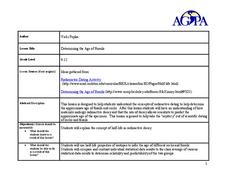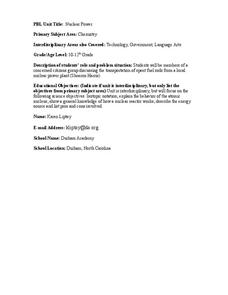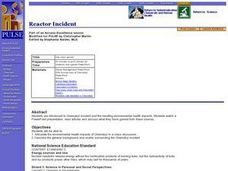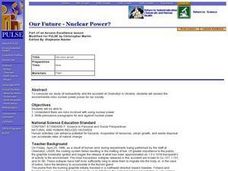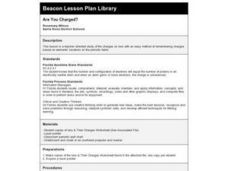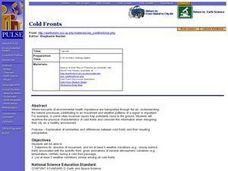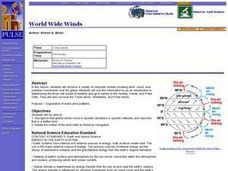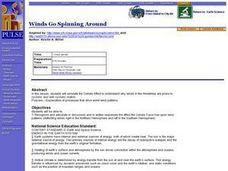Curated OER
Determining the Age of Fossils
High schoolers examine the concept of radioactive dating. In this radioactive dating instructional activity, students investigate how to determine the ages of fossils and rocks as they learn about half-life radioactive decay.
Curated OER
Atomic Structure
In this atomic structure learning exercise, students select answers to 8 fill in the blank questions on subatomic particles from the drop down box.
Curated OER
Nuclear Power
Students take on the role of members of a concerned citizens group and discuss the transportation of spent-fuel rods from a local nuclear power plant and the safety issues that surround the power plant. Students work in groups to write...
Curated OER
Radioactive Decay: A Sweet Simulation of a Half-life
Students demonstrate rates of decay of unstable nuclei can be measured. They understand ratios and multiplication of fractions. They simulate radioactive decay. They read about the accomplishments of scientists.
Curated OER
Quiz 1-Problem Solving and Naming Compounds
In this problem solving worksheet, learners are given five problems including calculating volume given the dimensions of a pool, determining the number of subatomic particles in an atom, filling in a table with chemical names and...
Curated OER
Radioactive Decay
Young scholars generate a radioactive decay table for an imaginary element, use their data to plot a decay graph, develop the concept of half-life, and use the graph to "age" several samples.
Curated OER
Reactor Incident
Students are introduced to Chernobyl incident and the resulting environmental health impacts they watch a PowerPoint presentation, read articles and discuss what they have gained from these sources.
Curated OER
Our Future - Nuclear Power?
Learners comprehend that there are risks involved with using nuclear power. They write persuasive paragraphs for and against nuclear power. Students analyze the environmental issues and risks with nuclear power.
Curated OER
Absolute Ages of Rocks
In this ages of rock instructional activity, students review the processes involved with determining the ages of rocks which includes the radioactive decay of carbon-14. This instructional activity has 5 matching and 5 short answer...
Curated OER
Elements
In this elements instructional activity, students determine the atomic number, mass, number, electrons, protons, and neutrons for elements. Students review the electromagnetic spectrum. This instructional activity has 1 graphic organizer...
Curated OER
Atomic Theory
In this atomic theory activity, students use Planck's constant, Rydberg constant, and Avogadro's number to complete 20 multiple choice questions.
Curated OER
How Do We Measure Absolute Time?-Geologic Clocks
In this absolute time worksheet, students define radiometric dating, tree rings and varves as means to measure absolute time. They are given information about each of these methods of dating.
Curated OER
Are You Charged?
Fourth graders study the charges on ions and familiarize themselves with a quick way to remember charges based on location of elements on the periodic table. They complete a worksheet and share their answers with the class.
Curated OER
A Phylogenetic Perspective for the Cladistically Challenged
Students use M&Ms to simulate radioactive decay of elements.
Curated OER
Electron Sqare Dance
Students participate in an Electron Square Dance in which they act the part of atoms. They follow the structure of different atoms suggested by the teacher.
Curated OER
How does Nuclear Fission differ from Nuclear Fusion?
Young scholars examine concepts of nuclear chemistry. They compare and contrast the topics of nuclear fission and nuclear fision. They predict the outcome of reactions based on the types of emissions and reactants.
Curated OER
Help Wanted: A Lighting Engineer For Popular Rock Group
Students are assigned to groups, and determine each member's role in the group. They will design an experiment to determine a way to produce the three primary and five secondary colors. Students discuss color and mood. They listen to a...
Curated OER
Acid Rain
Students use real-time weather maps to determine the likelihood of acid rainfall in a region. Students apply their understanding of interaction between weather systems, land and air pollution, to address acid rain and the effects on...
Curated OER
Atmospheric Cells
Students recognize that the sun is the source of energy driving atmosphere cells. They relate the motion of the atmospheric cells to mantle convection cells. Students recognize that the function of atmospheric cells is to move heat from...
Curated OER
Climate Patterns across the United States
Students articulate differences between climate and weather using examples in a written statement. Using climate data from across the country, they describe climate patterns for various parts of the United States on a map. Students...
Curated OER
Cold Fronts
High schoolers determine its' direction of movement, and list at least five weather conditions associated with the specific front, given animations of several atmospheric variables during a cold front passage. They list at least three...
Curated OER
Driving Currents
Learners conduct a variety of investigations to see how water, heat, and salinity affect the flow of the world's ocean currents,as well as, explore many factors that affect the flow of the world's ocean currents. They also describe in...
Curated OER
World Wide Winds
High schoolers recognize that global winds move in specific directions in specific latitudes and describe that in a written form. They relate the motion of the wind belts to historical navigation.
Curated OER
Winds Go Spinning Around
Students simulate the Coriolis Effect to comprehend why winds in the Westerlies are prone to cyclonic and anti-cyclonic motion. They arrive at an explanation of processes that drive world wind patterns
Other popular searches
- Isotopes & Atomic Mass
- Isotopes and Ions
- Isotopes and Atomic Mass
- And Isotopes
- Isotope Activities
- Atomic Number Isotope
- Radioactive Isotopes
- Isotopes Ions
- Isotopes Quiz
- Half Life of Isotopes
- Atomic Numbers and Isotopes
- Uses of Radioactive Isotopes


